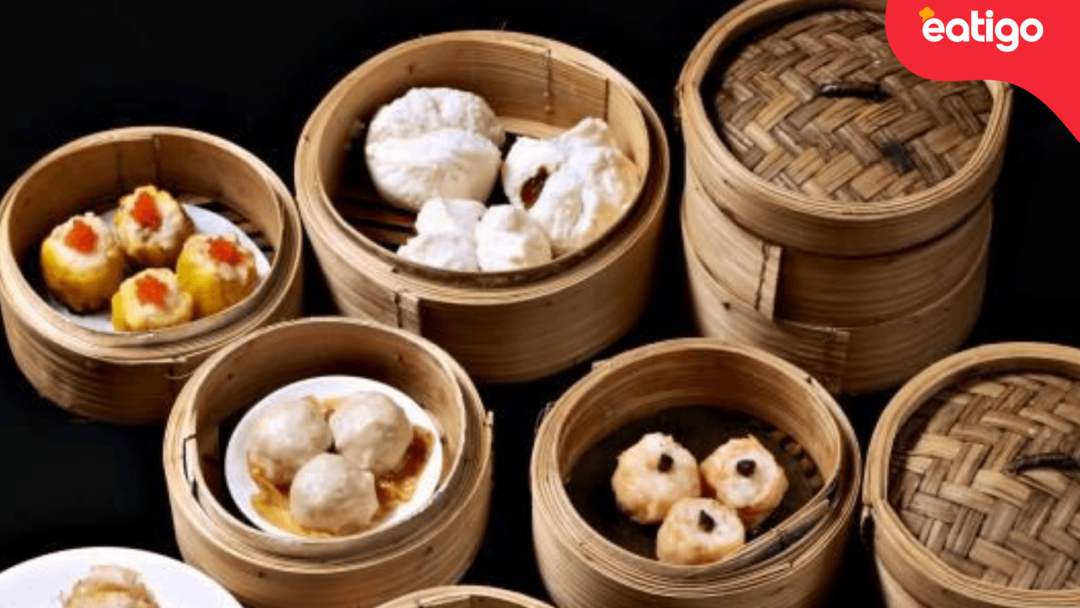What is Dim Sum? and where to try?

Top 17 Best Kepong cafe update 2025
October 8, 2024
29 best melaka food spots (October update 2025)
October 9, 2024Dim Sum is a beloved Chinese cuisine, known for its bite-sized portions and variety of flavors. Typically served with tea, Dim Sum includes a wide array of dishes such as steamed dumplings, buns, and rolls, offering a perfect blend of taste and tradition. Whether you’re indulging in fluffy steamed buns, shrimp dumplings, or crispy spring rolls, Dim Sum is more than just a meal—it’s an experience.
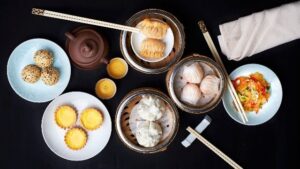
What is Dim Sum?
Dim Sum (点心) is a traditional Cantonese meal consisting of small, bite-sized dishes typically served with tea. The term “dim sum” means “touch the heart” in Chinese, highlighting the idea of these dishes being light and enjoyable, perfect for sharing. Dim sum is usually enjoyed during yum cha (饮茶), a tea-drinking meal, often consumed in the morning or early afternoon, particularly on weekends.
Origin of Dim Sum
Dim sum originated in southern China, particularly in the Cantonese-speaking regions like Guangzhou (Canton). It started as a snack for travelers at tea houses along the Silk Road and evolved into a social dining experience. Over time, it has become a beloved culinary tradition not only in China but also globally, especially in places with large Chinese communities.
Dim sum is typically served in restaurants where diners select from carts carrying various dishes, but it can also be ordered from menus in modern dim sum eateries.
Variety of Dishes
Dim sum offers a wide range of flavors and textures, including savory and sweet options. Popular dim sum items include:
- Dumplings: Steamed or fried dumplings such as har gow (shrimp dumplings) and siu mai (pork dumplings).
- Buns: Filled buns like char siu bao (barbecue pork buns) are a common favorite.
- Rice Rolls: Steamed rice noodle rolls filled with shrimp, beef, or vegetables, called cheung fun.
- Spring Rolls: Crispy rolls filled with vegetables, meat, or seafood.
- Congee: A rice porridge often served with various savory toppings.
Tea Pairing
Tea is an essential part of the dim sum experience. Common types of tea served include pu-erh, oolong, and jasmine
Type of dimsum
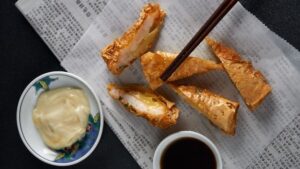
1.Har Gao (虾饺)
Har Gao (also known as shrimp dumplings) is a classic dim sum dish.The dumplings are renowned for their pleated design, which showcases the skill involved in their preparation.
- Dumpling Skin: Har Gao is known for its delicate, translucent wrapper made from a mixture of wheat starch and tapioca flour, giving it a slightly chewy texture.
- Filling: The filling primarily consists of fresh shrimp, often mixed with seasonings like ginger, garlic, and sometimes bamboo shoots or pork fat for added flavor.
2.Siu Mai (烧卖)
Siu Mai (also known as Shumai or Shao Mai) is a popular type of dim sum that is well-loved for its rich flavors and appealing presentation.Siu Mai is recognized for its slightly firm texture and savory filling. Its open-top design makes it easy to recognize and adds to its charm.
- Dumpling Skin: Siu Mai features a thin, round wrapper made from wheat flour. The wrapper is open at the top, showcasing the filling inside.
- Filling: The traditional filling usually consists of a mixture of minced pork and shrimp, often enhanced with ingredients like mushrooms, green onions, and seasonings such as soy sauce and sesame oil.
3.Char Siu Bao (叉烧包)
Char Siu Bao (叉烧包) is a beloved dim sum dish, known for its soft, fluffy buns filled with savory barbecue pork. The buns are known for their delightful combination of a soft exterior and a sweet, savory filling. The contrast in flavors and textures makes Char Siu Bao a favorite among dim sum enthusiasts.
- Bun Type: Char Siu Bao can be found in two main forms: steamed (the most common) and baked. The steamed version is soft and pillowy, while the baked version has a slightly crispier exterior.
- Filling: The filling consists of char siu (Chinese barbecue pork), which is marinated in a sweet and savory sauce made from soy sauce, hoisin sauce, honey, and five-spice powder. The pork is then diced and mixed with scallions and sometimes mushrooms for added flavor.
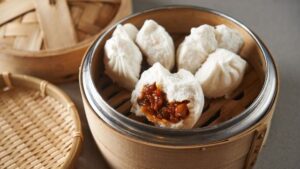
4.Cheung Fun (肠粉)
Cheung Fun (肠粉), also known as rice noodle rolls, is a popular dim sum dish known for its silky texture and versatility. The dish is known for its delicate, smooth texture and savory fillings. It can be enjoyed as a snack or as part of a dim sum meal, and it’s often appreciated for its ability to showcase the freshness of the ingredients.
- Noodle Rolls: Cheung Fun consists of wide, soft rice noodle sheets that are rolled up and filled with various ingredients. The texture is smooth and slightly chewy.
- Fillings: Common fillings include shrimp, beef, char siu (BBQ pork), and vegetables. Each roll can be customized based on preference.
5.Lo Mai Gai (糯米鸡)
Lo Mai Gai (糯米鸡) is a traditional Chinese dish often enjoyed as part of dim sum. The dish is celebrated for its savory filling and the chewy, slightly sweet texture of the sticky rice. The use of lotus leaves not only enhances the flavor but also gives the dish a traditional touch.
- Sticky Rice: Lo Mai Gai consists of glutinous rice (sticky rice) that is typically flavored with soy sauce and sometimes infused with other ingredients.
- Filling: The dish is commonly filled with a mixture of chicken, Chinese sausage, mushrooms, and sometimes dried shrimp, all seasoned with various spices and sauces.
6.Spring Rolls (春卷)
Spring Rolls (春卷) are a popular appetizer in Chinese cuisine, known for their crispy texture and versatile fillings. The contrast between the crunchy exterior and the flavorful filling makes spring rolls a favorite. They can be enjoyed on their own or as part of a larger meal.
- Wrapper: Spring rolls are made with thin, flour-based wrappers that are filled with various ingredients. They are rolled up tightly and then deep-fried until golden brown and crispy.
- Fillings: Common fillings include a mix of vegetables (like cabbage, carrots, and bean sprouts), meat (such as pork, chicken, or shrimp), and sometimes noodles. The filling can be seasoned with soy sauce, garlic, and other spices for added flavor.
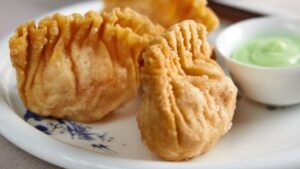
7.Turnip Cake (萝卜糕)
Turnip Cake (萝卜糕) also known as Lo Bak Go, is a traditional Chinese dish often enjoyed during dim sum. The dish is known for its savory flavor and chewy texture, with the crispy edges contrasting nicely with the soft interior. It is particularly popular during Chinese New Year, symbolizing prosperity.
- Main Ingredient: Despite its name, turnip cake is primarily made from grated daikon radish (turnip) mixed with rice flour, which gives it a unique texture.
- Additions: The mixture often includes ingredients like dried shrimp, Chinese sausage, and scallions for added flavor.
8.Phoenix Claws (凤爪)
Phoenix Claws (凤爪), also known as chicken feet, is a popular dim sum dish in Chinese cuisine. The texture is unique—soft and gelatinous, which some people find appealing. The dish is celebrated for its bold flavors and is often accompanied by a dipping sauce for added taste.
- Main Ingredient: Phoenix claws refer to the cooked feet of chickens, which are known for their gelatinous texture and rich flavor.
9.Egg Tarts (蛋挞)
Egg Tarts (蛋挞) are a popular pastry in Chinese cuisine, especially in dim sum and Cantonese bakeries. The combination of the flaky crust and creamy filling creates a delicious contrast in textures. Egg tarts are known for their rich, sweet flavor and are often enjoyed as a comforting treat.
- Pastry Base: Egg tarts feature a flaky or buttery pastry shell that is crisp and tender.
- Filling: The filling consists of a smooth, creamy custard made from eggs, milk, sugar, and sometimes vanilla or evaporated milk, creating a rich and slightly sweet flavor.
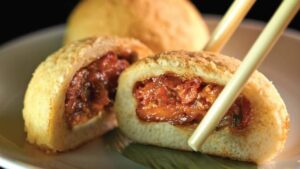
10.Congee (粥)
Congee (粥), also known as rice porridge, is a traditional Chinese dish that is enjoyed for breakfast or as a comforting meal at any time of day. Known for its versatility, congee can be adapted to suit different tastes and dietary needs. It is often considered comfort food, particularly when one is feeling under the weather.
- Base Ingredient: Congee is primarily made from rice, which is cooked with a large amount of water or broth until it breaks down into a creamy, smooth consistency.
- Texture: The result is a warm, soothing porridge that can range from thick to thin, depending on personal preference.
Where to try dim sum in KL?
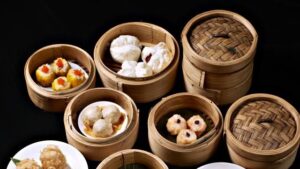
1.Lai Ching Yuen Restaurant @ Grand Millennium
With a traditional design and a reputation throughout Kuala Lumpur for their dim sum, the skilled chefs at Lai Ching Yuen offer a thoughtfully curated menu of authentic Cantonese cuisine, prepared exclusively with the highest quality and freshest ingredients just for you.
Location: https://maps.app.goo.gl/T9MpMKmZtMecdxsh9
2.Red Chinese Cuisine @ Pullman KLCC
Discover the newest and most exciting dining destination in Kuala Lumpur. RED represents a fresh take on Chinese cuisine, blending modern style with innovative ideas. It specializes in live seafood, dim sum, traditional favorites, and a rotating selection of signature dishes crafted by a talented team. The dining space features stunning architectural design with a chic and social atmosphere, along with four exclusive VIP rooms perfect for business meetings, family gatherings, or lavish entertaining. Serving lunch from noon to 2:30 PM and dinner from 6:30 PM to 10:00 PM, open daily. Experience the RED evolution you won’t want to miss!
Location: https://maps.app.goo.gl/m5EptSry6wr8KaBj9
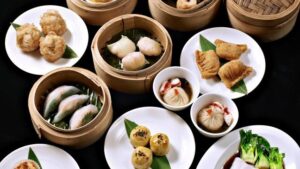
3.Tung Yuen Chinese Restaurant
Unsure of where to dine? Visit Mardhiyyah Hotel & Suites, where our talented chefs have crafted special menus for you. If you’re in the mood for Cantonese cuisine, don’t miss the menu specials at Tung Yuen Chinese Restaurant.
Location: https://maps.app.goo.gl/3iiH16DKPJm1XYri6
Summary
In this blog, we’ll explore the origins of Dim Sum, its cultural significance, and the best places where you can enjoy authentic Dim Sum, from local favorites to renowned international spots. Get ready to discover the world of Dim Sum and where to savor this delightful cuisine!

